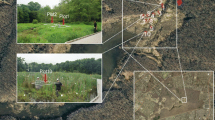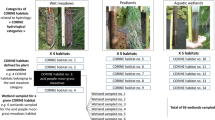Abstract
In this study, the relationship among water quality, soil properties, and plant coverage in the region of the Akarçay stream was examined. Correlation analyses were carried out between soil samples taken from each of four plant communities in the Akarçay basin and water in the Akarçay stream. The four plant communities in the study area are as follows: Limonium lilacinum (Boiss. et Bal.) Wag., Alhagi pseudalhagi (M. Bieb.) Desv. Peganum harmala L., and Hordeum marinum Huds. subsp. marinum. B, Cl, EC, K, Mg, Na, pH, and SO4 data from both soil and water samples were subjected to statistical analysis, and significant correlations were obtained (p < 0.05). These correlations indicated that the chemical features of the soil had a major effect on water quality. The important parameters were B, Cl, EC, K, Mg, Na, pH, and SO4 for Limonium lilacinum communities; Ca, K, and pV for Peganum harmala; and B, Cl, Mg, pH, and pV for Alhagi pseudalhagi. There were also statistically significant relationships (p < 0.05) among the parameters examined. These findings strongly suggested that these plant communities can be used as indicators for soil chemistry and water quality.







Similar content being viewed by others
References
Ahearn DS, Sheibley RW, Dahlgren RA, Anderson M, Johnson J, Tate KW (2005) Land use and land cover influence on water quality in the last free-flowing river draining the western Sierra Nevada, California. Journal of Hydrology 313:234–247
Akman Y, Daget P (1971) Quelques aspects synoptiques des climates de la Turquie. Bull Soc Lang Geogr 5(3):270–300
APHA (American Public Health Association) (1995) Standard methods for examination of water and waste water, 19th edn. APHA, Washington, DC
Çelik MY, Sabah E (2002) The geological and technical characterization of Ömer-Gecek geothermal area and the environmental impact assessment of geothermal heating system in Afyon, Turkey. Environmental Geology 41(8):942–953
Davis PH (ed) (1965–1988) Flora of Turkey and the East Aegean Islands, vols I–X. Edinburgh University Press, Edinburgh
Dinges R (1978) Aquatic vegetation and water pollution control public health implication. American Journal of Public Health 68:1202–1205
Emberger L (1952) Sur le quotient pluviothermique. Comptes Rendues de l’Academie des Sciences Paris 234:2508–2510
Gaussen H (1954) Theories et classification des climates et microclimats. VIII Congr Int Bot Paris, pp 125–130
He C (2003) Integration of geographic information systems and simulation model for watershed management. Environmental Modelling & Software 18:809–813
Isidori M, Lavorgna M, Nardelli M, Parrella A (2004) Integrated environmental assessment of Volturno River in South Italy. Science of the Total Environment 327:123–134
Kargıoğlu M (2001) Afyonkarahisar çevresi flora ve vejetasyonu. İn: Afyonkarahisar kütüğü 1. Uyan M et al (eds) Afyonkarahisar, pp 49–60
Lyon J, Gross NM (2005) Patterns of plant diversity and plant-environmental relationship across the riparian corridors. Forest Ecology and Management 204:267–278
Norton MM, Fisher TR (2000) The effects of forest on stream water quality in two coastal plain watersheds of the Chesapeake Bay. Ecological Engineering 14:337–362
Scholz M, Trepel M (2004) Water quality characteristics of vegetated groundwater-fed ditches in a riparian peatland. Science of the Total Environment 332:109–122
SIHM (State Institution of Hydraulic Works) (2005) Annual quality observation. General Directorate, Ankara
State Meteorology Works General Directorate (1990) Meteorological bulletin. Research and Computer Center Department Presidency, Ankara
Tezcan L (1999) Akarçay Havzası Hidrojeolojisi ve yeraltısuyu akım modeli. Hacettepe Universitesi Uluslararası karsts u kaynakları uyg. Araş. Mrk., Araştırma projesi, Ankara
Tüzüner A (1990) Laboratory handbook for soil and water analyses. Agriculture and Forest Ministry Rural Services General Directorate, Ankara
Uslu S (1958) Kurak zamanların tesbitinde esas kullanılan klima-diagram. İ.Ü Orm Fak Derg 8(2):95–104
Walter H (1955) Die Klima-Diagramme als Mittel zur Beurteilung der Klimaverhältnisse für ökologische, vegetationskundliche und landwirtschaftliche. Zwecke Ber Dt Bot Ges 68:331–334
Yurdakulol E, Ercoşkun T (1990) Orta Anadoluda çorak alanların vejetasyonu üzerine ekolojik ve sintaksonomik araştırma. Turkish Journal of Botany 14:109–123
Acknowledgment
The authors wish to thank Dr. H Shazly, Swansea, UK, for pre-editing this paper.
Author information
Authors and Affiliations
Corresponding author
Rights and permissions
About this article
Cite this article
Serteser, A., Kargιoğlu, M., Içağa, Y. et al. Vegetation as an Indicator of Soil Properties and Water Quality in the Akarçay Stream (Turkey). Environmental Management 42, 764–770 (2008). https://doi.org/10.1007/s00267-008-9165-8
Received:
Revised:
Accepted:
Published:
Issue Date:
DOI: https://doi.org/10.1007/s00267-008-9165-8




